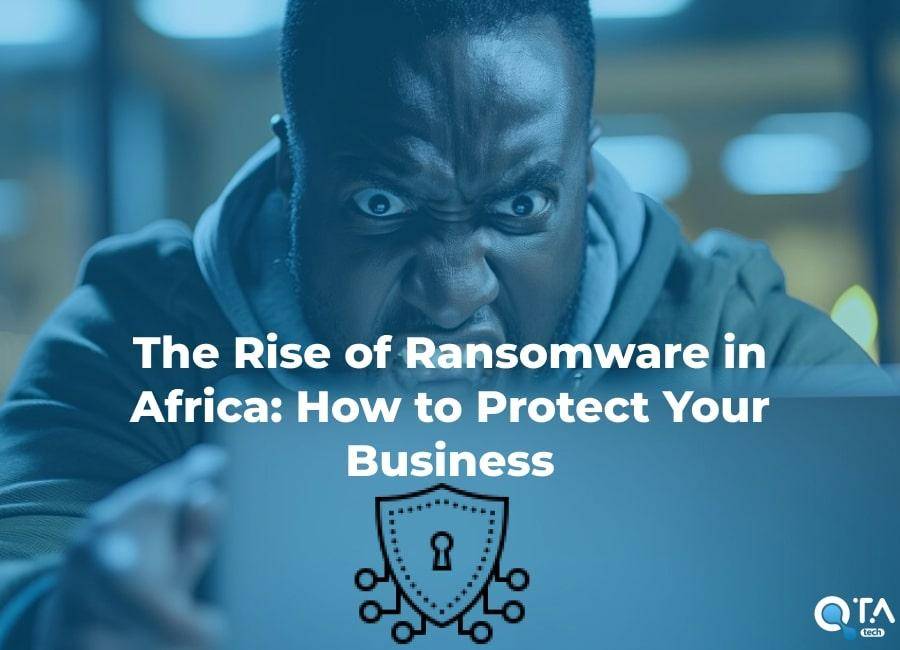The Rise of Ransomware in Africa: How to Protect Your Business
Ransomware has become a major threat to businesses worldwide, and Africa is no exception. These malicious programs encrypt user data and demand a ransom to unlock it, experiencing exponential growth across the African continent. This article explores the increase in ransomware attacks in Africa and offers prevention and response strategies to protect businesses.
I. The Increase in Ransomware Attacks in Africa
1. Factors Contributing to the Rise of Ransomware
Several factors contribute to the rise in ransomware attacks in Africa:
- Rapid Digitization: Many African businesses are adopting digital technologies at an accelerated pace, often without adequate security measures.
- Lack of Awareness: Many business leaders and employees are not sufficiently trained in cybersecurity risks.
- Weak Security Infrastructure: Some businesses, especially SMEs, do not invest enough in robust cybersecurity infrastructures.
- Deliberate Targeting: Cybercriminals see African businesses as easy targets due to security and regulatory gaps.
2. Notable Attack Examples
Several recent attacks have highlighted the vulnerability of African businesses:
- Johannesburg University Hospital: In 2021, this healthcare facility fell victim to a ransomware attack that paralyzed its IT systems, compromising patient care.
- Banco de Moçambique: A 2022 attack disrupted banking services, causing significant financial losses and affecting customer trust.
II. Prevention Strategies
Preventing ransomware attacks requires a multidimensional approach involving technological measures, organizational practices, and ongoing training.
1. Keep Systems and Software Updated
Maintaining up-to-date operating systems, software, and applications with the latest security patches is crucial. Updates often fix vulnerabilities that cybercriminals exploit to launch attacks.
2. Use Robust Security Solutions
Investing in advanced cybersecurity solutions such as firewalls, antivirus software, and intrusion detection and prevention systems can significantly reduce the risk of ransomware infections.
3. Train Employees
Raising employee awareness of cybersecurity risks is essential. Regular training on recognizing phishing emails, secure password practices, and incident response protocols can prevent many attacks.
4. Implement a Rigorous Backup Policy
Regular and secure backups of critical data allow for the restoration of information in the event of a ransomware attack without having to pay the ransom. The 3-2-1 rule is recommended: three copies of the data, on two different media, with one copy off-site.
III. Response Strategies
Even with strong preventive measures, no business is entirely immune to ransomware. Here’s how to respond effectively in case of an attack.
1. Isolate the Infected System
As soon as a ransomware infection is detected, it is crucial to isolate the affected system to prevent the malware from spreading to other parts of the network.
2. Inform the Relevant Authorities
Reporting the incident to local authorities and cybersecurity teams can help coordinate an effective response and potentially identify the attackers.
3. Assess the Impact and Decide on Actions
Evaluate the extent of the damage and decide if data restoration from backups is possible. Paying the ransom is never recommended as it does not guarantee data recovery and funds criminal activities.
4. Apply Lessons Learned
After an attack, it is essential to review and improve security measures to prevent future infections. This includes updating security policies, enhancing training, and investing in advanced security technologies.
Conclusion
The rise of ransomware in Africa represents a significant challenge for businesses. However, by adopting robust prevention measures and being prepared to respond effectively in case of an attack, businesses can protect their data and minimize the impact of ransomware. QTA TECH stands ready to support African businesses in their cybersecurity efforts, offering tailored solutions to enhance their resilience against digital threats.
